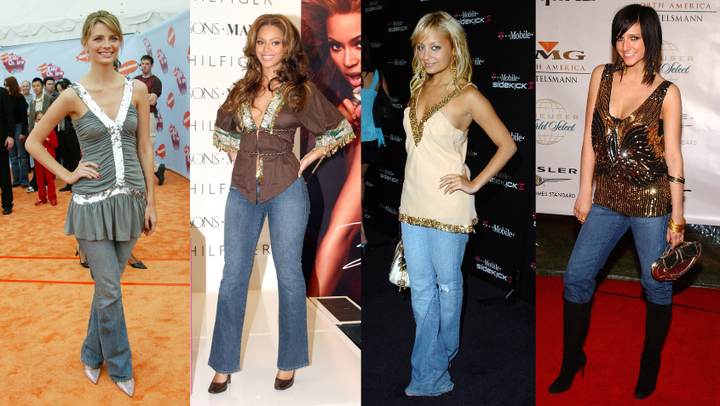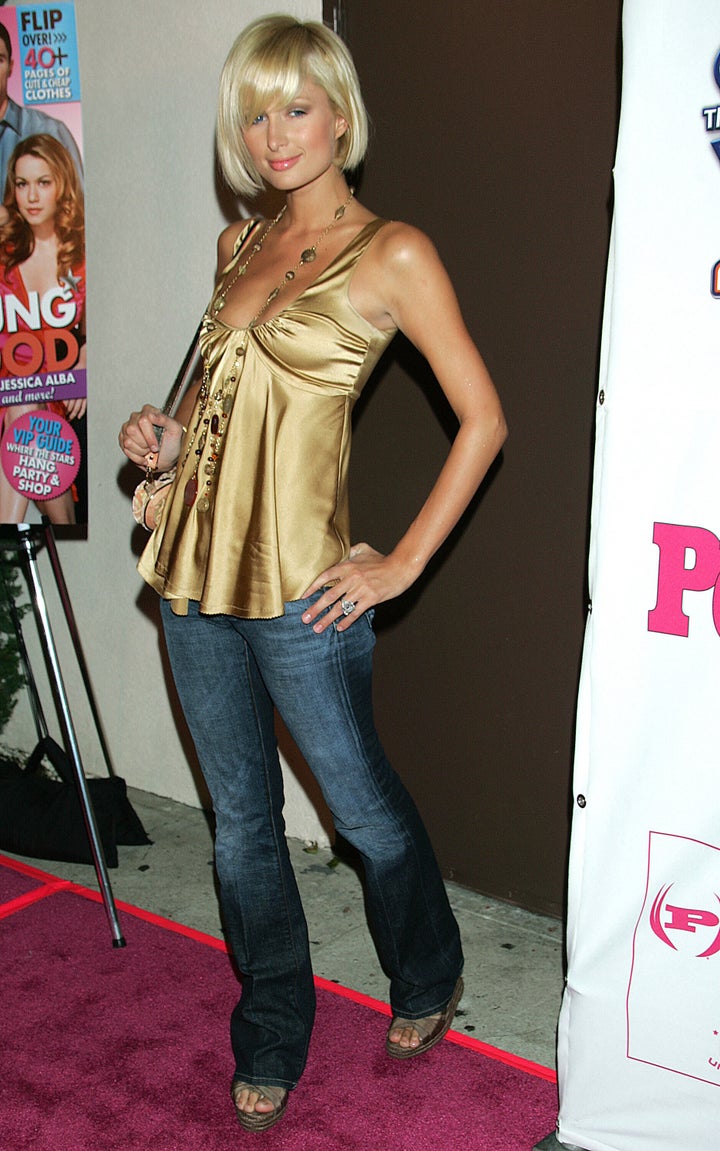
Style trends today encompass a range of evening outfit options, from dresses to matching sets to cozy sweaters (or sweatsuits and loungewear in the lockdown era of the COVID-19 pandemic). But back in the early to mid-aughts, one nighttime look reigned supreme: jeans with a “going-out top.”
The going-out top was a staple at early 2000s house parties, bars, clubs, red carpet events and beyond. For millennial women, the term evokes images of halters, tube tops and bejeweled numbers from retailers like Forever 21, Express, Bebe, Charlotte Russe and Wet Seal.
“As someone who was in high school and college in the early to mid-2000s, I definitely feel a lot of nostalgia upon hearing the term ‘going-out top’!” said Sara Idacavage, a fashion historian currently doing research in the textiles, merchandising and interiors department at the University of Georgia.
“That period of time coincided with the meteoric rise of fast fashion retailers, so I recall it being very easy to purchase a lot of interesting ‘going out’ tops for a relatively small amount of money, which was very exciting for a young college student like me at the time,” she said.
The Allure Of The Going-Out Top
Affordable going-out tops were the natural pairing for the designer it-jeans of that time like True Religion, 7 for All Mankind and Citizens of Humanity, which felt like necessary investment pieces.
“The denim was the fixed part of the uniform at the time, so the top and shoes were where you could experiment,” said pop culture commentator and “Be There in Five” podcast host Kate Kennedy, who sells sweatshirts that read “going out top” in her merch store. “The back pocket of those jeans was a status symbol, and you spent so much money on your jeans that you had like $20 left for your shirt.”
A going-out top typically had some element that upgraded it to look a little fancier than a regular top ― like sequins, gems, lace, ruching, a bubble hem, or an alternative neckline. Young women strapped for cash could buy a variety of low-cost options to reflect changing styles, so these certainly weren’t high-quality, sustainable choices. But they were fun and somewhat versatile.
“I think the silhouettes of these tops were often more loose and forgiving,” Kennedy recalled. “Low-rise jeans left so much real estate in the torso, so these tops were longer and often empire-waisted and flowy. When I lived in my sorority house, women of different sizes would exchange going-out tops ― they lent themselves to different body types, whereas the pants were more difficult to figure out.”
The rise of Facebook and the trend of posting photos from every night out further contributed to the importance of mixing up your going-out tops, as each would be documented on social media. The trend-setting celebrities of the time certainly understood that.
“When I talk about going-out tops in a pop-culture context, I always think of the heyday of the paparazzi outside nightclubs like Les Deux problematically seeking bleary-eyed photos of famous women on the party scene, like Paris Hilton and Nicole Richie but also Lindsay Lohan, Hilary Duff, Mischa Barton, even Ashlee and Jessica Simpson,” Kennedy said. “The tube tops, bandanas, or higher-end things they wore trickled down and were the model for the tops ‘normal people’ bought.”
The Origins Of The Going-Out Top
“Like so many things in fashion, the going-out top was not new to the millennia, nor was it a phenomenon exclusive to women’s fashion,” said Cassidy Zachary, a fashion historian and co-creator of the podcast “Dressed: The History of Fashion.”
She pointed to the 1960s Youthquake cultural movement as one early iteration or potential origin for the going-out tops that thrived in the early aughts. Youthquake fashion was revolutionary, as rebellious youth and young designers rejected both social and sartorial conventions.
“These acts of defiance are reflected in men’s incorporation of bold patterns and colors ― often through shirts ― back into their wardrobes and women’s adoption of pants and miniskirts paired with a separate top,” Zachary said. “Youthquake designers like Betsey Johnson were selling blouses designed specifically to sparkle during a night out on the town.”
“This continues into the ’70s and beyond,” she added. “Look to any images from night clubs of the era to see that going-out tops ― sequined, beglittered, hand crocheted! ― were a genderless expression of individuality chosen specifically for that evening. This legacy extends to this very day.”

Idacavage looked back a little further, highlighting the versatility and mix-and-match capabilities of going-out tops.
“This concept is certainly not remarkable to us today, but the advent of mix-and-match separates in Western fashion during the 1940s and 1950s had a significant impact on the world of fashion,” she explained. “Pioneered by American ready-to-wear designers like Claire McCardell, the concept of mix-and-match separates allowed women to dress for a variety of occasions and activities without having to completely change one’s outfit or purchase an entirely new look. The concept of chic, comfortable, mix-and-match pieces is the ethos of American fashion design.”
The mid-20th-century concept of mix-and-match separates generally involved casual wear rather than ensembles for a night on the town, but Idacavage believes this changed in the 1970s for a number of reasons.
“When it came to dressing up and going out, music and dancing definitely impacted the type of clothing being worn ― just think about the clothing being at Studio 54 as compared to what was worn in punk venues,” she noted. “The 1970s were also the time when designer jeans become popular, pioneered by a licensing agreement between socialite Gloria Vanderbilt and Murjani jeans in 1976. This led to jeans becoming seen as fashionable items and markers of social status, which led to more jeans being worn out to clubs and the need for special going-out tops to go with those jeans.”
The Disappearance Of The Going-Out Top
If the going-out top developed in the 20th century and thrived in the early 2000s, why is it no longer the gold standard today? Or does it still exist in some form?
Kennedy believes there was a shift during the 2010s that elevated fashion and beauty to a point where people decided to dress up both during the day and at night.
“I think people wear going-out outfits now,” she said in reference to the trends of the past few years (apart from our pandemic sweatpants period when no one went out at all). “In the past, expensive jeans with a specific silhouette were the norm, and the flexibility you had was with your top. Now people are all about matching sets or wear dresses or experiment with what they wear on the bottom, especially since influencers kind of democratized the people we look to for style inspiration.”
In the Instagram era, we can show off our ensembles at any time without having to go out in public. But back then, going to a party or bar was an opportunity to be seen, so there was a sense of novelty and needing to leave an impression with your jeans and going-out top combo.
“Today, there are a lot of creative people with amazing taste that young people can look at, so we aren’t limited to diluted versions of what celebrities are wearing,” she continued. “People still wear things to go out in, but it’s not as much of a ‘Mad Libs’ of jeans and tops.

Idacavage believes the going-out top still exists today, even if we don’t use the term as much anymore. She emphasized that the way we describe garments depends on “socio-cultural factors that are unique to particular time periods and places,” so the meaning of the terminology can vary in different contexts.
“What was once considered a ‘going out’ top in the early aughts could be considered a ‘regular’ top today, and the same is true across different social groups, geographic areas, etc.,” she noted. The style shifts during the COVID-19 pandemic support this theory, as people are finding ways to express their creativity while dressing comfortably and casually.
“I think the pandemic has definitely led many people to invest in clothing items that provide visual interest from the waist up, which is certainly true for myself! I have a whole selection of interesting tops that I wear for Zoom dates or lectures, which I often (secretly) pair with sweatpants,” Idacavage explained.
As a doctoral student in a college town, Idacavage has also observed contemporary iterations of the going-out top among Gen Z-ers.
“I see lots of cheap, flashy tops being sold in the stores in the town where I live, and notice that they’re also being worn by many of the younger students who go out on the weekends,” she said. “I’ve also noticed that groups of girls often wear the exact same bottoms ― such as a certain style of jeans ― but seem to express themselves more with what they wear on top.”
For millennial women, the nostalgia for the going-out top may be less about its absence in fashion today and more about the evolution of their lives and personal styles.
“The older I get, the more I wear what I want, as opposed to following a formula for what is cute or how to look nice,” Kennedy said. “And I think a lot of millennial women’s lives change drastically when they have kids.”
“I don’t go out to bars in huge groups or get reservations for 12 anymore,” she said, “so thinking about the ‘going-out top,’ it’s less the top itself but more the spirit of what that meant and how fun it was to be in large groups of women trying to look cute and not knowing what the night had in store.”
